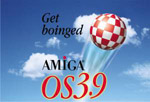
Main
What's New?
About
Introduction
Abbreviations
Installation Tips
Icon Operation
Compatibility
Disk and File Operation
Internet Applications
Keyboard Shortcuts
Undocumented Features
Third Party Utilities
Miscellaneous
Known Bugs
Disclaimer
Disk and File Operation
Please note the following from Martin Steigerwald of Haage & Partner:
Use a boot partition within the first 4GB of the hard drive as long as you are not absolutely sure that you really understand in which circumstances you can use a partition not within the first 4GB and are in absolute agreement to take the full responsibility on what you are doing and promise faithfully that you will not contact AmigaOS 3.9 support when something goes wrong.
Simply put, boot partitions beyond the first 4GB partitions are NOT officially supported; but can work under special circumstances at your own risk.
- I have a 4-way buffered interface; why won't my system boot up?
- I have a Power Flyer in my Amiga. Is there anything to be aware of in regards to OS 3.9?
- Is there a way to make CacheCDFS automatically recognize AudioCDs? When I insert an AudioCD into my CD-ROM drive, all that appears is a ghosted "CD0:Uninitialized" icon.
- HDToolBox shows my Maxtor hard drive as half its actual capacity. Is there a solution?
- What Mask value(s), Maxtransfer, and block sizes do you recommend for use with my Amiga?
1.
| Q: | I have a 4-way buffered interface; why won't my system boot up? |
|---|---|
| A: | Assuming IDEFix uses a custom scsi.device, all you need to do is change the SetPatch invocation in S:Startup-sequence to read: C:SetPatch QUIET SKIPROMUPDATES "scsi.device" [David Rey] |
| Q: | I have a Power Flyer in my Amiga. Is there anything to be aware of in regards to OS 3.9? |
|---|---|
| A: | Elbox stated in a news announcement: "From ATA3.driver v6.0 on, you no longer need to add the 'SKIPROMUPDATES scsi.device' or 'NONSD' options in the Setpatch command." Earlier versions of the Power Flyer still require the SKIPROMUPDATES "scsi.device" option called from SetPatch in your S:Startup-sequence file (i.e. C:SetPatch SKIPROMUPDATES "scsi.device"). It is also recommended that you disable all scsi.device entries in DEVS:NSDPatch.cfg, as the Power Flyer's scsi.device is already NSD compliant. [Ondra Zima/Johan "Graak" Forsberg] |
| Q: | Is there a way to make CacheCDFS automatically recognize AudioCDs? When I insert an AudioCD into my CD-ROM drive, all that appears is a ghosted "CD0:Uninitialized" icon. |
|---|---|
| A: |
Simply add the following line to the CONTROL field of the CacheCDFS DosDriver mount file (CD0: or whatever) "AUDIO=Sys:Utilities/PlayCD" (be sure to remove any "NOAUDIO" text if it exists). Also make sure there's a "CDDA.info" file in ENVARC:. When you insert a CDDA, CacheCDFS brings that icon as appicon up and when you doubleclick the icon, PlayCD will be started. The line should look something like this (yours may vary slightly): Control = "MD=1 LC=1 DC=8 S L LV AL LFC=1 HR=.rsrc Q MSDOS AUDIO=Work:Audio/PlayCD" [Stephan Rupprecht] |
| Q: | HDToolBox shows my Maxtor hard drive as half its actual capacity. Is there a solution? |
|---|---|
| A: |
Disable the "Cylinder Limitation Option" jumper on your Maxtor hard drive (this option is on all Maxtor drives). HDToolBox should now recognize the entire capacity of your hard drive when "read configuration" is selected. [Matthew] |
| Q: | What Mask value(s), Maxtransfer, and block sizes do you recommend for use with my Amiga? |
|---|---|
| A: | I actually did tests with "Diskspeed" (from the SFS package) in reading large files for a report in the German Amiga print magazine "Amiga-Magazin" and those tests suggest that a block size from 1024 to 4096 bytes is best for FFS. With 512 bytes you have slow operation on large files and more than 4096 does not yield any visible improvement unless perhaps you use insanely large files. IMO 512 bytes shouldn't be used, and anything above 4096 bytes is useless space waste. I most often use 1024 bytes, and it works reasonably well. For a partition which stores CD images or big backup files, you might want to use 2048 or even 4096 bytes. Mask should be 0xfffffffc in most configurations. Use a Maxtransfer of 0x00ffffff for SCSI, good IDE drives and controllers, but use 0x0001fe00 for IDE drives that still do not support reading more than 128KB in one access—I had a 28GB drive that did not support it properly. Old IDE drives might even require 0x0000fe00. To be on the safe side, I recommend using 0x0001fe00 for IDE drives, but you can try a larger value and then see if copying large files with a big buffer size (aka copy bigfile hd2: BUF=5000) gives a byte-for-byte identical copy of the file or not. [Martin Steigerwald] |